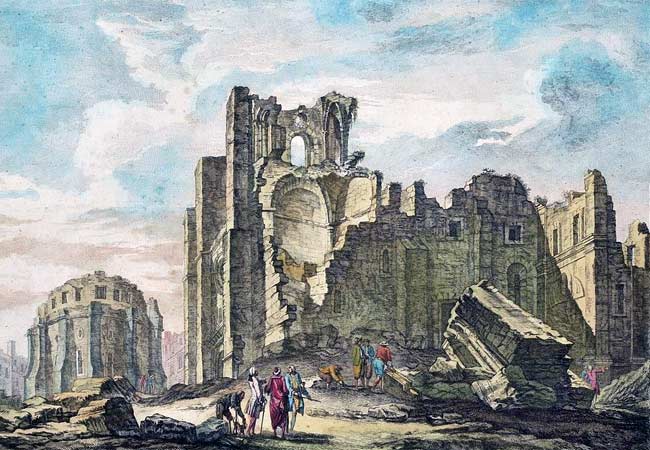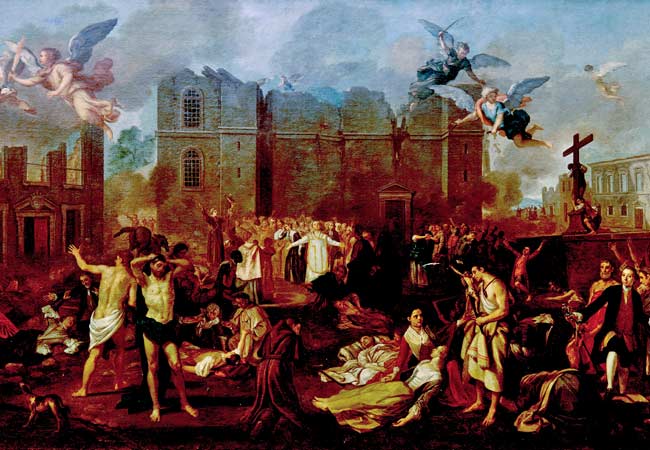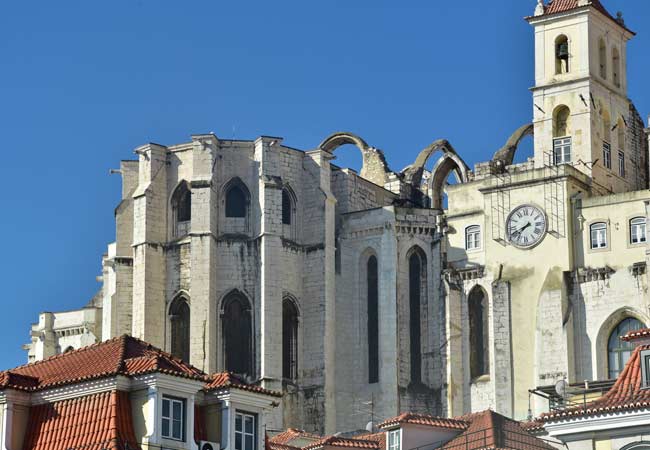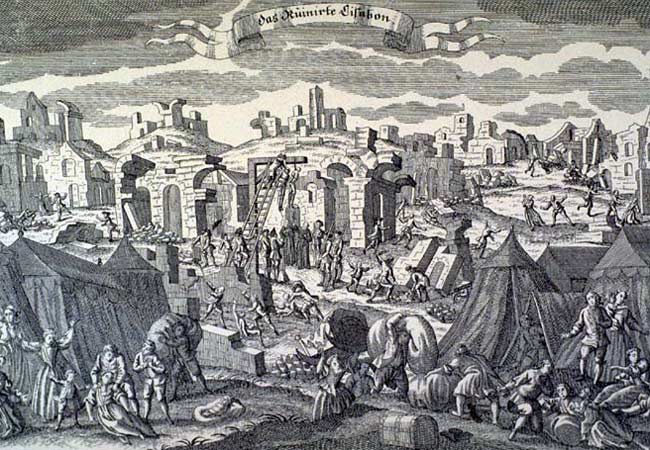LisbonLisboaPortugal.com
The best independent guide to Lisbon
LisbonLisboaPortugal.com
The best independent guide to Lisbon
The Lisbon Earthquake of 1755
On the morning of the 1st of November 1755, one of Europe's most powerful earthquakes struck Lisbon.
By the end of the week, 75,000 people in Lisbon had died as a direct result of the earthquake, making the earthquake of 1755 one of the most deadly natural disasters the world has ever experienced. The devastation caused many Portuguese to question their religious beliefs and the horrific event has shaped Lisbon's history ever since.
The earthquake struck on the 1st of November, which was the holy feast day of "All Saints". On the day, the deeply religious Portuguese packed Lisbon's churches to celebrate this important feast day. The medieval construction of the churches were not designed to withstand the violent earth movements and many unfortunately worshippers died as the roofs of the religious buildings collapsed on them.

The Sé Cathedral after the earthquake as painted by Jacques-Philippe Le Bas in 1757
There has been much discussion on the estimated size of the earthquake, but it is believed to be between magnitude 8.5-9.0. The first tremor of the earthquake struck partway through the Latin church service at 10:24am.
For the religious celebration, every candle in every church was lit, and the churches were decorated with flowers and flammable decorations. As the tremors rocked the churches, the candles tumbled, igniting the decorations, and creating massive fires which ravaged Lisbon for five further days after the earthquake.
The quake shock Lisbon for three and a half minutes, and during this time two-meter-wide cracks appeared in the streets. The petrified inhabitants of Lisbon feared it was the end of the world, and rushed from the compact city for the safety of the open docks, unaware of the impending tsunami.

The “Alegoria ao Terramoto de 1755", by João Glama Strobërle
The epicentre for the 1755 earthquake was 320 km to the south-west of Lisbon, in the middle of the Atlantic Ocean. The earthquake was a massive slip of the Azores-Gibraltar Faultline, which created one of the largest tsunamis to hit Europe. The tsunami struck Lisbon 45 minutes after the earthquake, as much of the city was burning.
Before the tsunami hit, the water drained from the Rio Tejo estuary, revealing shipwrecks loaded with treasure. Thousands of people raced into the muddy river to claim the riches, but no person of that era could predict what was about to be unleashed upon the city of Lisbon.....
The tsunami was estimated to be 9 meters high when it hit Lisbon. The destructive wave was funnelled up the River Tagus estuary, rapidly flooding all low-lying land, which included the present-day areas of Baixa and Belem.
An account of the time reads, "(the tsunami) arrived so fast that several people riding on horseback ... were forced to gallop as fast as possible to the upper grounds for fear of being carried away."
There were two further two tsunami waves to strike Lisbon within the following three hours that proceeded the earthquake. Thousands who had escaped the earthquake's destruction, were either drowned, killed by debris or dragged out to sea by the tsunami.

The ruins of the Igreja do Carmo Church in Lisbon
The higher areas of Lisbon that had escaped the torrents of water were no safer, as by the time the tsunami hit, great swathes of the city were on fire. Many of these fires started in the churches, as the candles lit for the feat day toppled and ignited the dried flowers. If the earthquake had hit on any other day, the destruction and death would have been significantly less.
A week after the earthquake, over 90% of the buildings in Lisbon had either collapsed by the earthquake, been flooded by the tsunami or burnt by the fires. The destruction included the 70,000-volume royal library, the royal Ribeira Palace and the whole of the Baixa district.
Many of Lisbon's ancient churches were destroyed included the Sé Cathedral and the Igreja do Carmo. The Igreja do Carmo was never rebuilt and remains as a permanent memorial of the destruction that befell the city. Surprisingly the roof of the Mosteiro dos Jeronimos in Belem, with its spindly stone columns, did not collapse.
Another area of the city to avoid much of the destruction was the Alfama district, which at that time housed many of the city's poor and destitute. The district extends over a hill with a solid stone bedrock that shock less during the quake and was high enough to avoid the tsunami.

The rebuilding of Lisbon under the guidance of Marquis of Pombal
King Joseph I avoided the earthquake and tsunami, as his daughter wished to spend the public holiday at the coast. The royal court had attended an earlier church service and relocated to Cascais when the earthquake struck.
After the earthquake, King Joseph I became excessively paranoid and refused to sleep within a walled building. He had the entire royal court relocated from the (destroyed) Ribeira Palace to a large, tented complex in Ajuda, on the site of the present-day Palácio Nacional da Ajuda.
The prime minister, Sebastião de Melo (known by history as the Marquis of Pombal), proved to be an adept leader in the face of such a catastrophe. When asked what to do immediately after the quake, Pombal replied, "Bury the dead and heal the living". He overruled the church and prevented an epidemic of diseases by loading the dead onto damaged ships and burning the bodies out to sea.
The rebuilding of Lisbon was rapid, in just over a month, Manuel da Maia, the chief engineer, had designed five plans for the rebuilding of Lisbon. One of the suggestions was to completely abandon the city as the destruction was so extensive.
The Marquis of Pombal selected a plan to rebuild Lisbon, which replaced the narrow streets of the medieval district with straight avenues and grand plazas – and this is the Baixa district of today.
The reconstructed buildings included one of the earliest examples of earthquake proofing, based on the concept of "it shakes but doesn't fall down". The buildings were constructed from stone but built around a wooden structure, which provided flexible during an earthquake. These buildings were tested by simulating an earthquake, with the army matching up and down the streets!
The statue of the Marquis of Pombal stands at the top of the Avenida da Liberdade overlooking his masterpiece of Baixa.
Discover more of Lisbon with our most popular guides
If you've found our content valuable, we'd welcome your support.
The digital publishing landscape has evolved significantly. As a small independent publisher, we face growing challenges. Search engines increasingly favour paid content over organic results, while AI-generated content often reproduces original work without attribution.
To support our work, please consider bookmarking this page (press Ctrl + D) for quick access. If you find an article helpful, we'd be grateful if you'd share it with friends on social media.
For specific questions, please see our Reddit community at r/LisbonPortugalTravel.
Should you notice any outdated or incorrect information, please contact us at [email protected]
Thank you for helping us continue to provide valuable content in an increasingly challenging digital environment.
A complete list of all of our Lisbon articles
If you've found our content valuable, we'd welcome your support.
The digital publishing landscape has evolved significantly. As a small independent publisher, we face growing challenges. Search engines increasingly favour paid content over organic results, while AI-generated content often reproduces original work without attribution.
To support our work, please consider bookmarking this page (press Ctrl + D) for quick access. If you find an article helpful, we'd be grateful if you'd share it with friends on social media.
For specific questions, please see our Reddit community at r/LisbonPortugalTravel.
Should you notice any outdated or incorrect information, please contact us at [email protected]
Thank you for helping us continue to provide valuable content in an increasingly challenging digital environment.































